

What Is Digital Literacy? While the word “literacy” alone generally refers to reading and writing skills, when you tack on the word “digital” before it, the term encompasses much, much more.

Sure, reading and writing are still very much at the heart of digital literacy. But given the new and ever-changing ways we use technology to receive and communicate information, digital literacy also encompasses a broader range of skills—everything from reading on a Kindle to gauging the validity of a website or creating and sharing YouTube videos. The term is so broad that some experts even stay away from it, preferring to speak more specifically about particular skills at the intersection of technology and literacy. The American Library Association’s digital-literacy task force offers this definition: “Digital literacy is the ability to use information and communication technologies to find, evaluate, create, and communicate information, requiring both cognitive and technical skills.” Finding and Consuming. DigiLitEYWP. From Written to Digital: The New Literacy. Both the 21st-century economy and the careers needed to fuel it are changing at an unprecedented rate. Students must be prepared for nonlinear careers, pivoting to match the ever-changing work landscape.
We thus need to rethink not just how we teach our students but what we teach our students. The Definition Of Digital Literacy. The Definition Of Digital Literacy by Terry Heick When we think of digital literacy, we usually think of research–finding, evaluating, and properly crediting digital sources.
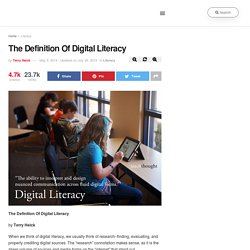
The “research” connotation makes sense, as it is the sheer volume of sources and media forms on the “internet” that stand out. But we are living in a world where the internet is disappearing, replaced by sheer connectivity. Digital literacy and why it matters. Digital Literacy – What is digital literacy? Why Digital Skills Matter. Digital Literacy Framework - Grades 9-12. Contrary to popular belief, cyberbullying remains a problem in high school.
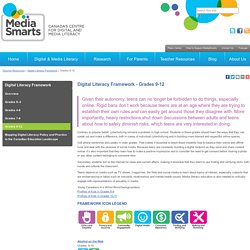
Students in these grades should learn the ways that they can speak out and make a difference, both in cases of individual cyberbullying and in building more tolerant and respectful online spaces. Cell phone ownership also peaks in older grades. That makes it essential to teach these students how to balance their online and offline lives and deal with the stresses of social media. The Importance of Digital Literacy for Students.
Digital LIteracy for Students. What Is Digital Literacy? Digital Literacy for Students with Disabilities. Digital LIteracy for Students. Learning Through Digital Media. Teaching With and About Technology. Jim Wilson/The New York TimesStudents have always faced distractions and time-wasters.
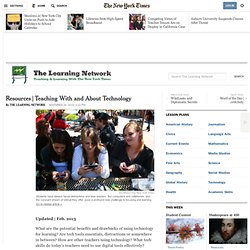
But computers and cellphones, and the constant stream of stimuli they offer, pose a profound new challenge to focusing and learning.Go to related article » Updated | Feb. 2013 What are the potential benefits and drawbacks of using technology for learning? Are tech tools essentials, distractions or somewhere in between? Common Misconceptions of Educators Who Fear Technology. Education is currently at a crossroads as traditional methods and tools are changing as a result of advances in technology and learning theory.

We are beginning to see some schools across the country take the lead in merging sound pedagogy with the effective integration of technology. These schools and educators, whether they realize it or not, are not only enhancing the teaching and learning process, but they are also providing their learners with essential skill sets pivotal for success in today’s society. These skill sets include critical thinking/problem solving, media literacy, collaboration, creativity, technological proficiency, and global awareness. Teaching Students to Effectively Use the Internet. A search engine is essentially a database that points to Web sites and Internet resources.

The search engine database is compiled by means of often called spiders, crawlers, or bots. These spiders, crawlers and bots are programmed to find web pages, follow all the links they contain and add any new information they find to the master database. It is important to remember that when you are using a search engine, you are not really searching the entire Internet, but a database of pages and resources from the Internet compiled by the bots. How to Infuse Digital Literacy Throughout the Curriculum. So how are we doing on the push to teach “digital literacy” across the K12 school spectrum?

From my perspective as a school-based technology coach and history teacher, I’d say not as well as we might wish – in part because our traditional approach to curriculum and instruction wants to sort everything into its place. Digital literacy is defined as “the ability to effectively and critically navigate, evaluate, and create information using a range of digital technologies.” Many educational and business professional cite is as a critical 21st century skill. Even so, many schools have struggled to adapt it into their curriculum.
5 Dimensions Of Critical Digital Literacy: A Framework. 5 Dimensions Of Critical Digital Literacy: A Framework Digital Literacy is increasingly important in an age where many students read as much on screens as they do from books.
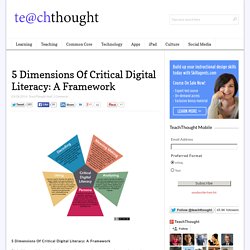
In fact, the very definition of many of these terms is changing as the overlap across media forms increases. Interactive eBooks can function like both long-form blogs and traditional books. Threaded email can look and function like social media. Email and texting and social media messaging are increasingly similar. Digital Differentiation. Technology is a tool that can be used to help teachers facilitate learning experiences that address the diverse learning needs of all students and help them develop 21st Century Skills.

At it's most basic level, digital tools can be used to help students find, understand and use information. When combined with student-driven learning experiences fueled by Essential Questions offering flexible learning paths, it can be the ticket to success. Response: Reading Digitally vs. Reading Paper (Opinion) (This is the first post in a two-part series) This week’s question is: Which is better for students -- reading paper or reading digitally?
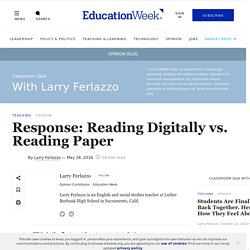
The urgent need for media literacy in an age of annihilation. From fictitious organizations posting polarizing messages on Facebook to robustly researched news stories being labelled “fake,” the pervasive power and importance of the media are clear. And yet what is most concerning is not that fictitious stories are being shared as “real” and well-researched stories are labelled “fake.” Rather, the biggest problem is the lack of stories about how to thoughtfully address the situation not only through media regulation but also through education. By focusing on media challenges one at a time as they arise, an opportunity is being missed to address the media’s messages and power systemically. Looking for Quality Sources? Follow These Guidelines - Cornerstone University. Not all information is good information.
You may have noticed this truth with the recent “fake news” trends. Just because it’s published somewhere, whether online or in a print article, doesn’t make it fact. Assessing Source Quality. Especially if you are surfing the web, your research process should commence with a quality check of any sources you plan to use. Many writers begin badly in this area, simply typing, say, "genetics" into a search engine and getting a return of over 90,000 hits. The likely result is an arbitrary research process, yielding sources vastly varying in quality. The first step when writing a research paper should always be narrowing your focus and choosing quality sources to fit the circumstances. To run a quality check on your sources, follow these guidelines: The Classroom Guide to Digital Literacy in K-12 Education. Digital literacy is more than just a new buzzword for educators and administrators. While we are all familiar with the traditional concept of literacy in the classroom, digital literacy builds upon the same idea to include the technology that is now being incorporated into learning and instruction.
What is digital literacy? Use digital sources critically - Digital Literacy - Research Guides at University of Cincinnati. 3 ways to help students do efficient online research. Turning Your Students Into Web Detectives. How to Spot Fake News - FactCheck.org. OWL Purdue: Evaluating Sources. Tips to Find Credible Sources for Research: A Guide for Students. How to Evaluate Sources. Evaluating Sources for Credibility.
Critical Evaluation. Padlet For Teachers: The Best Tips, Tricks, and Ideas For Your Classroom. 15 Ways to Make Google Classroom Better for Everyone by Vicki Davis. Lingro: The coolest dictionary known to hombre! TrackStar : Home. Vocabulary Words - Spelling Practice - Phonics Games for Kids. Flashcard Stash. Thesaurus and Word Tools. Visual Dictionary Online. Lexipedia. 9 Unique Ways to use Technology in the Classroom. 25 Fun Apps And Websites To Teach Kids About Technology.
Scrible – Modern research platform for school and work. VideoAnt. Edpuzzle. Empower Every Voice. Create your own video easily I Free. Book Creator - bring creativity to your classroom - Book Creator app. Storykit - Making your stories happen. Easy Bib - Get Help Creating Your Works Cited Page (Bibliography) Instructional Content Platform.
Create interactive lessons. How to Use Prezi. What is Quizlet? Flocabulary - Educational Hip-Hop. Beliefs for Integrating Technology into the English Language Arts Classroom. Integrating Technology Into The English Language Arts Classroom - 2 Peas and a Dog. Teaching the English Language Arts With Technology: A Critical Approach and Pedagogical Framework – CITE Journal. Teaching with Technology in a Language Arts Classroom. Incorporating Technology into the Modern English Language Arts Classroom.